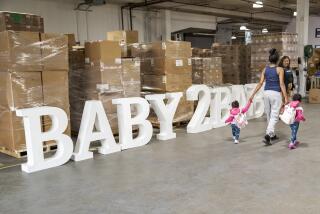One Last, Year-End Look at the Passing Parade of People in the News : Happy and Healthy
View has revisited some of the people and places it reported on in the last several months. Among them:
--Hollywoodâs Masquers Club, which because of declining funds sold its building and moved.
--Jimmy and Ricky Sperry, blinded in an accident 11 years ago, who received cornea transplants in August.
--Balu Natarajan, who triumphed over 167 other youngsters to win the National Spelling Bee in June.
Rory Clark says he is not particularly religious. But recalling when his wife, Karen, was rushed to UC San Diego Medical Center in premature labor with their first child, he said: âWe know there is a God. We were in the right place at the right time.â
At first, they were told that their daughter Jennifer, born two months too early, would not survive. She weighed less than three pounds and suffered from a severe case of respiratory disease syndrome. Because the hospital is the only one in the country to keep an amniotic fluid bank, Jennifer became the ninth infant in the nation to receive human surfactant, a soaplike substance found in the amniotic fluid of mature fetuses.
In a July story, the Clarks credited the rare and experimental substance with helping Jennifer breathe on her own and avoid the need for long-term, artificial ventilation, which is blamed for chronic lung disease in one-third of such cases.
Now that Jennifer is a happy and healthy 2-year-old, the Clarks have discovered that Karen is pregnant again. âMy first reaction was paralysis,â said Rory Clark, who worried that the uterine deformity that caused his wifeâs first preterm labor will cause another.
Once more, he believes they are in the right place at the right time. Now, through another unusual program at UCSD, the couple are receiving state-of-the-art instruction in how to prevent premature births.
Looking for Warnings
The program--one of five in the country--focuses on training high-risk pregnant women to detect the signs of premature labor, said Dr. Thomas Key, director of perinatal medicine at UCSD. Those at risk include women with previous preterm deliveries or uterine malformations, like Karen Clark; those carrying multiple fetuses; those with several previous uterine operations; those who bleed throughout pregnancy, and drug users, he said. They are taught to detect subtle signs of early labor such as unusual contractions and pelvic pressure, mucus discharge, diarrhea or nausea, he said.
Those who detect the signs and come to the hospital immediately may be given drugs to halt labor contractions, he said. In the last four years, the program has reduced premature births by 75% among women in the study, he said.
Both Keyâs study and UCSDâs amniotic fluid bank are funded by the March of Dimes, which calls premature births the leading unresolved issue in obstetric health care. About 7% of all births are premature and prematurity is the cause of death in the first month of life for 75% to 90% of all otherwise normal newborns, according to the March of Dimes. As many as 40% of mentally disabled adults were premature babies, Key said.
âThere are no guarantees in this, but I remain optimistic, Karenâs got a good chance for a good outcome,â Key said.
âThe first time, I was not aware of anything,â said Karen Clark. âI thought it (labor) was gas. This time, when it starts to happen, Iâll be prepared. Iâll call the doctor and lie down.â
Rory Clark said he is looking forward to whatever happens. He said he is still not religious. âBut I believe a baby is a blessing. Itâs a spiritual experience for me and that excites me.â
More to Read
Sign up for Essential California
The most important California stories and recommendations in your inbox every morning.
You may occasionally receive promotional content from the Los Angeles Times.










